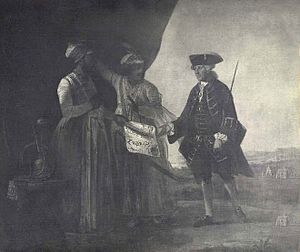William Watts (East India Company official) facts for kids
William Watts (born around 1722 – died 4 August 1764) was an important British official. He worked for the East India Company, a powerful trading company. Watts played a key role in changing who ruled Bengal, which helped the Company gain more control in India. He also became very wealthy. His wife, Begum Johnson, had many famous family members, including a future Prime Minister of the United Kingdom.
Contents
Early Life and Family
William Watts was born around 1722. His father, also named William Watts, was a teacher in London.
On March 24, 1749, William Watts married Frances Altham in Calcutta. She was a widow and well-connected to important people. Frances is famously known as Begum Johnson. She lived most of her very long life in Calcutta, which later became the main city for British rule in India. This marriage helped William Watts connect with important governors in India.
Career with the East India Company
Watts was in charge of the Cossimbazar factory (a trading post) for the East India Company. Robert Clive, a famous British leader, chose Watts to represent the Company at the court of the Nawab (the ruler) in Murshidabad.
Secret Plans and the Battle of Plassey
Clive asked Watts to help with a secret plan. The goal was to remove the current ruler, Siraj ud-Daulah, and put a new ruler in his place who would be friendly to the British. Watts secretly met with important nobles and commanders (called emirs) from the Nawab's court. These included Mir Jafar, Rai Durlabh, and Yar Lutuf Khan.
Watts was a big part of the secret plan against Siraj Ud Daulah. This plan led to the famous Battle of Plassey. On June 5, 1757, Watts met Mir Jafar and got him to promise his loyalty to the British.
Rewards and Return to England
Because of his help, William Watts received a large sum of money, about £114,000, from the Nawab's treasury. He was also made the governor of Fort William on June 22, 1758. This was after the previous governor, Roger Drake, had left the fort when it was attacked. Just four days later, Watts resigned as governor. He let Robert Clive take over so he could return to England.
Later Life and Legacy
After returning to England, William Watts built a large house called South Hill Park in Berkshire. Today, this building is an arts centre.
Watts died in August 1764 and was buried in Hanslope. His book, Memoirs of the Revolution in Bengal, was published in the same year he died.
Family Connections
William and Frances Watts had three children who lived to adulthood. These children also had famous descendants who were important in politics and building the British Empire.
- Their daughter, Amelia, married Charles Jenkinson. He was a close advisor to King George III. Amelia died young, at age 19, shortly after giving birth to her son, Robert. Robert later grew up to become the Prime Minister of the United Kingdom.
- Their daughter, Sophia, married George Poyntz Ricketts. He became the governor of Tobago in 1793 and then the governor of Barbados in 1794. Their son, Charles Milner Ricketts, worked in India as a respected administrator. After he retired, he became a Member of Parliament (MP) in England.
- Their son, Edward, lived at Hanslope Park. In 1778, he married Florentia, whose father, Alexander Wynch, had been the governor of Madras.


